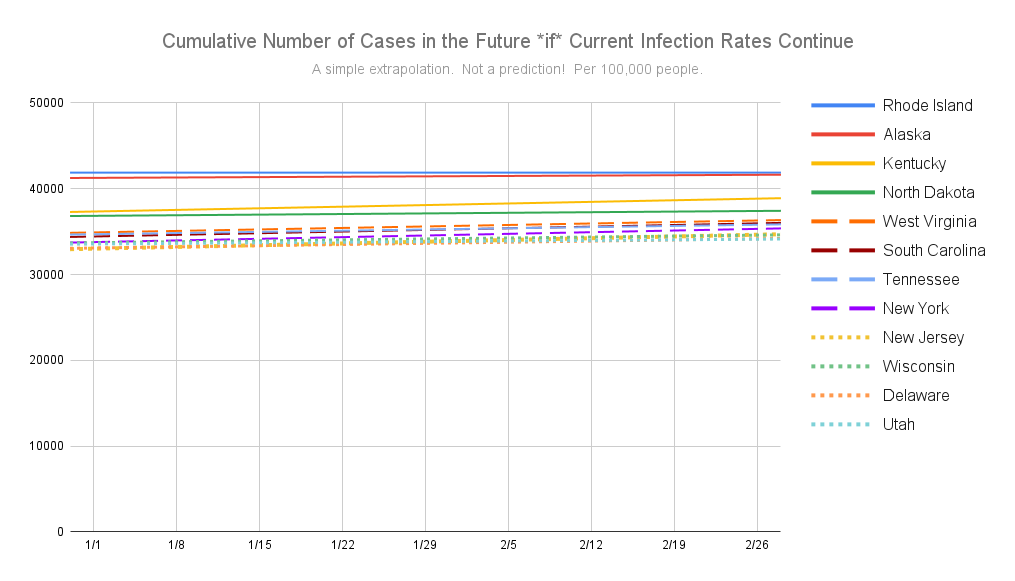As a step toward getting this working again, I've switched to slower technology which usually works.
When I get more time ....
Comparing the COVID-19 Pandemic Among the States
Per Capita
Contents:
The Relative Infection Rates of the States
Which States Have Had the Most Total Infections?
Just an Extrapolation (not even a wild guess)
How Much Should We Care about COVID-19?
Notes:
-
Except where noted, all numbers are per capita scaled to be the number per 100,000 people.
Per capita numbers help understand how likely it is that the person approaching you has the virus; raw counts are only(?) useful to figure out where resources should be devoted.
-
This is not copyrighted so may be freely used with or without attribution.
-
The numbers should be taken with a grain of salt due to the lack of testing, overwhelmed
infrastructure, differing definitions of which cases qualify, and the motivations of the people who
collect and approve the numbers.
E.g.,
fewer than half the states are following federal recommendations to report probable novel coronavirus cases and deaths, ....
-
Changing the width of the browser's window may change the sizes of the charts.
-
Except where noted, the numbers are from The New York Times.
Relative Infection Rates of the States
Etc.
Which States Have Had the Most Total Infections? Deaths?
Bonus reading: COVID-19 Cases Are Rising, So Why Are Deaths Flatlining?, July 9, 2020.
This shows what would happen unless infection rates are changed.
How Much Should We Care about COVID-19?
These numbers are from various sources.
From What Young, Healthy People Have to Fear From COVID-19, September 9, 2020:
"Several studies of asymptomatic patients revealed that more than half of them had lung abnormalities. A March study published in the Journal of the American Heart Association found that 7 to 20 percent of sick patients showed heart damage associated with COVID-19.
"As my colleague Ed Yong explained, many COVID-19 patients experience protracted illness. These "long-haulers" suffer from a diabolical grab bag of symptoms, including chronic fatigue, shortness of breath, unrelenting fevers, gastrointestinal problems, lost sense of smell, hallucinations, short-term-memory loss, bulging veins, bruising, gynecological problems, and an erratic heartbeat. And according to the neuroscientist David Putrino, chronic patients are typically young (the average age in his survey is 44), female, and formerly healthy.
"Research from Italy found that roughly nine in 10 hospitalized patients said they still had symptoms after two months. A British study reported a similar risk of long-term illness.
[A man in his 30s] "has one-in-100 chance of developing a long-term illness after contracting COVID-19."
From How Do COVID-19's Annual Deaths and Mortality Rate Compare to the Flu's?, August 27, 2020:
| | 2017-2018 Flu | 2018-2019 Flu | COVID-19
|
| Cases | 45 million | 35 million | 5 million
|
| Deaths | 61,000 | 34,157 | 180,000+
|
| Rate* | 0.14% | 0.10% | 3.6%
|
* = my calculation
From the CDC, June 5, 2020:
See below for estimated percent of adults with confirmed COVID-19 reported in the U.S:
| | Adults 65-84 | Adults 85+
|
| Hospitalizations | 31-59% | 31-70%
|
| Admission to intensive care | 11-31% | 6-29%
|
| Deaths | 4-11% | 10-27%
|
From Many Stay Sick After Recovering From Coronavirus, July 7, 2020:
"Roughly one in 10 people with the disease continue to suffer from unexplainable symptoms for more than a month, many for more than two months. The most common are exhaustion, headaches, a loss of smell, trouble breathing, dizziness, diarrhea and skin rashes. "And some of our participants still have a fever after three months," Spector says.
"Severe damage to the lungs, heart and nervous system in some people is also of concern. The disease can cause cardiac arrhythmia or even trigger diabetes mellitus. Some patients suffer from severe concentration and memory disorders, much like dementia. Even young people can be affected. More than 1,000 children around the world have contracted multisystem inflammatory syndrome in connection with a SARS-CoV-2 infection, which can lead to myocarditis and circulatory failure."









